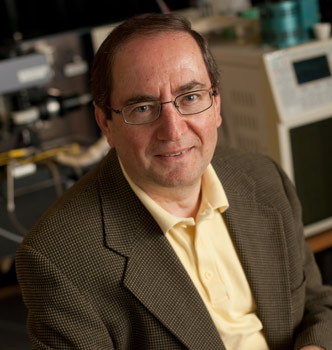Taking aim at acid gases

Researchers in the new EFRC, including Lehigh’s Israel Wachs, hope to improve the performance and durability of the catalysts, membranes and other agents that convert acid gases to less harmful compounds.
A coalition of seven research institutions has received an $11.2 million grant to streamline the removal of acid gases from large-scale energy applications.
The four-year award from the U.S. Department of Energy will be shared by the Georgia Institute of Technology, Washington University in St. Louis and the Universities of Alabama, Florida and Wisconsin, as well as Lehigh and Oak Ridge National Laboratories. The institutions have formed an Energy Frontier Research Center (EFRC) for Understanding and Control of Acid Gas-induced Evolution of Materials for Energy (UNCAGE-ME).
Georgia Tech is lead university for the project. Israel E. Wachs, director of Lehigh’s Operando Molecular Spectroscopy and Catalysis Research Lab, is Lehigh’s lead researcher.
Acid gases, including CO2, sulfur oxides (SOx), nitrogen oxides (NOx) and hydrogen sulfide (H2S), are generated by automobiles, fossil-fuel power plants, natural gas extraction, refineries, chemical manufacturing and other activities. Acid gases harm people, trees and crops. CO2 and NOx are also greenhouse gases.
Scientists use membranes and sorbents to separate and concentrate CO2 for carbon sequestration. Reactive catalysts convert acid gases to less harmful compounds. The performance and durability of these agents can be undermined by the degrading effects of acid gases. The researchers hope to prolong the lifetimes of the agents by better understanding how acid gases interact with them.
The researchers are performing molecular spectroscopic studies of the surface functionalities and bulk structures of membranes, sorbents and catalysts and combining these studies with multiscale computational and theoretical modeling of the agents’ interactions with acid gases.
The project has four thrust areas—the interaction of acid gases with nonporous oxide-based solids, with disordered porous solids and with the external surfaces of porous materials; and the effect of defects and dopants on acid gas interactions with ordered porous materials.
Wachs, a leader in the first and second thrusts, is renowned for using molecular spectroscopy to study the surfaces of heterogeneous catalysts under processing conditions and for exploring the relationship between catalysts’ structure and their activity for photocatalysis, environmental catalysis, fuels, chemicals and other applications.
“Supported amines, carbide-derived carbons and other disordered porous materials attract acid gases,” said Wachs. “We want these materials to have long-term sustainability and not be poisoned by the acids.
“We’re looking at the interaction of acid gases with interior pores and with the surfaces of porous materials, and learning to make 2D oxides, nanoporous materials and metal organic frameworks. Very little work has been done in this area.
“This new research center gives us an army of people to collaborate with. It’s a fantastic and exciting opportunity.”
Posted on:


